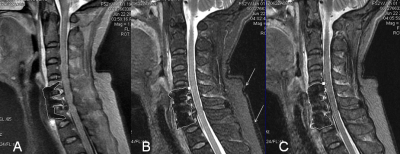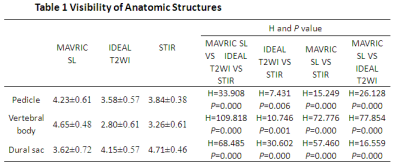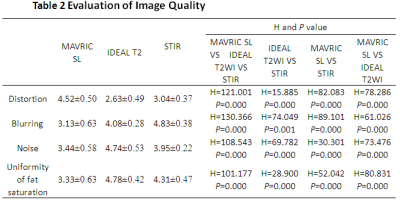5154
MR Imaging of Patients Receiving Anterior Cervical Discectomy and Fusion Surgery Using MAVRIC-SL-STIR Technique1Department of Radiology, Renmin Hospital of Wuhan University, Wuhan, China, 2GE Healthcare, Beijing, China
Synopsis
Metal implants are now very common in modern joint and spine surgeries. However, conventional MR images are significantly compromised by implant-induced magnetic susceptibility artifacts. A novel metal artefacts reduction technique, termed MAVRIC-SL was proposed. The purpose of this study is to evaluate its clinical feasibility and diagnostic value in patients after anterior cervical discectomy and fusion surgery compared with routine 2D FSE images at 3 T. As a result, although the image quality of MAVRIC-SL is limited at 3 T, it can still provide important additional diagnostic information through substantially reduced metal artefacts.
Introduction
Metal implants are now very common in modern joint and spine surgeries. However, conventional MR images are significantly compromised by implant-induced magnetic susceptibility artifacts, which will limit the accuracy of image interpretation.1, 2Minimizing metal artifacts can offer great helps to better depict the metallic implants and surrounding anatomic structures. Meanwhile, uniform fat suppression is beneficial to improve detection rate of lesions, such as tumor, bleeding, edema, infection and so on.3 Therefore, minimizing metal artifacts and acquiring optimal effect of fat suppression are crucial for post-surgery evaluation of patients with fixed metallic implants. Lately, a novel MRI technique, termed MAVRIC-SL (Multi-Acquisition with Variable Resonance Image Combination SeLective) was proposed, which combines the slice-encoding metal artifact correction (SEMAC) with Multi-Acquisition with Variable Resonance Image Combination (MAVRIC). This technique shows a significant advantage on metal artifacts reduction.4 Furthermore, MAVRIC-SL-STIR combines the 180o inversion pulse with MAVRIC-SL for fat suppression.The purpose of this study is to evaluate the clinical feasibility and diagnostic value of MAVRIC-SL-STIR in patients after anterior cervical discectomy and fusion surgery compared with routine 2D FSE images at 3 T MRI.
Methods
Institutional review board approval and informed consent were obtained for this study. Images were acquired on a 3.0 T MR scanner (GE Medical Systems, Milwaukee, WI). In all, 15 patients (9 males and 6 females, average age: 53.6±14.5) after anterior discectomy and fusion surgery from 5 days to 6 years were included in this study. Besides the routine cervical spine protocols, an additional MAVRIC-SL-STIR sequence was scanned in sagittal plane with similar spatial resolution to compare with the routine 2D FSE images (IDEAL T2WI and STIR). For quantitative evaluation, the areas of metal artifacts regions were manually outlined and measured in the mid-sagittal plane by the same radiologist for all of the three techniques (MARVRIC-SL, IDEAL-FSE and STIR-FSE).Statistically comparison of the areas of metal artifacts among these three techniques were conducted using a Two-way ANOVA test. For qualitative evaluation, two musculoskeletal radiologists analyzed the image quality including geometric image distortion, blurring, noise and uniformity of fat suppression by consensus using a five-point scale (1, severe artifacts and non-diagnostic; 5, nearly no artifacts and definitively diagnostic).Besides, the visibility of three anatomic structures including the pedicle, vertebral body and dural sac near the implants were also assessed using a five-point scale (1, anatomic structure not visible; 5, good delineation of anatomic structure). Comparison among these techniques was performed using a Kruskal-Wallis H test.Results
Respective advantages were acquired by the three techniques (Fig.1). The mean areas of metal artifacts regions for MAVRIC-SL-STIR, IDEAL T2-weighted and STIR images were 428.467mm2, 875.667mm2,and 800.200mm2 , respectively. The area of metal artifacts was significantly reduced on MAVRIC-SL-STIR images (P=0.002).However, the difference between IDEAL T2WI and STIR was not significant (P=0.193). Table 1 shows the comparison results of image quality scores. MAVRIC-SL-STIR demonstrated superior image distortion (P <0 .001). Image noise and uniformity of fat saturation for IDEAL T2WI were significantly better (P <0 .001), while blurring was less in STIR images. Table 2 summarizes the visibility scores of anatomic structures for comparison among the three techniques. MAVRIC-SL-STIR acquired the best visibility of the pedicle and vertebral body (P <0 .001). However, the visibility of the dural sac for MAVRIC-SL-STIR images were decreased (P <0 .001).
Discussion and Conclusion
As shown in the results, MAVRIC-SL-STIR can effectively reduce the metal artifacts and improve delineation of the metallic implants compared to STIR and IDEAL T2WI. But it suffers from image blurring which mainly caused by long echo train length (ETL=20) and excitation mode of RF pulse.4 In addition, the relative long acquisition time (about 11 minutes) may bring a risk of motion artifacts. Moreover, the fat suppression of MAVRIC-SL-STIR was reduced compared to IDEAL technique, which using the three-point water-fat separation method. In conclusion, although the image quality of MAVRIC-SL-STIR sequence is limited at 3 T, its clinical application for patients after anterior cervical discectomy and fusion surgery is feasible and it can provide additional diagnostic information through substantially reduced metal artefacts.Acknowledgements
The authors thank Xixiang Chen, Li Qiu, Tianyuan Yu, Liang Cheng, Cuili Kuang for assistance during MR imaging.References
1.Viano, A. M., Gronemeyer, S. A., Haliloglu, M. and Hoffer, F. A., Improved MR imaging for patients with metallic implants, Magnetic Resonance Imaging, 2000, 18(3):287-295.
2.Hargreaves, B., Worters, P. W., Pauly, K. B., Pauly, J. M., Koch, K. M. and Gold, G. E., Metal Induced Artifacts in MRI, Ajr American Journal of Roentgenology, 2011, 197(3):547-555.
3.Rutherford, E. E., Tarplett, L. J., Davies, E. M., Harley, J. M. and King, L. J., Lumbar spine fusion and stabilization: hardware, techniques, and imaging appearances, Radiographics A Review Publication of the Radiological Society of North America Inc, 2007, 27(6):1737-1746.
4.Koch, K. M., Brau, A. C., Chen, W., Gold, G. E., Hargreaves, B. A., Koff, M. and Mckinnon, G. C., et al., Imaging near metal with a MAVRIC‐SEMAC hybrid, Magnetic Resonance in Medicine Official Journal of the Society of Magnetic Resonance in Medicine, 2011, 65(1):71-82.
Figures


MAVRIC-SL=Multi-Acquisition with Variable Resonance Image Combination SeLective; IDEAL= Iterative Decomposition of water and fat with Echo Asymmetry and Least-squares estimation; STIR=Short inversion Time Inversion Recovery.
